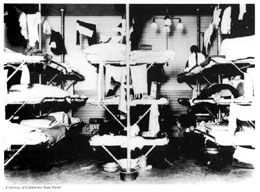Teachers, Like Students, Learn by Doing: Project Learning at Envision Schools
Your content has been saved!
Go to My Saved Content.A quote by experiential-education pioneer Kurt Hahn projects brightly onto a large screen: "We are crew, not passengers." After a brief welcome, the thirty-five new teachers at Envision Schools are asked to respond to the quote in their journals. Then, following some quiet reflection time, the teachers meet their fellow group members. (Groups are heterogeneous -- teachers come from different schools and content areas and have varying levels of technical expertise.) Within their new group, teachers then discuss their response to the quote and how they think the quote will impact the way they work as a whole over the next two days.

The Envision Schools facilitator then leads an activity on the attributes of high-quality stories. Next, she asks, "What do you think is happening in this photo?"
After discussing the photo, she then projects the graph below. "What could this data possibly be describing?" she asks, challenging this group of teachers-as-students.
Credit: Bob Lenz
"Together, we will explore the essential question 'Why do we exclude people?' by exploring the Angel Island Immigration Station," the facilitator explains. "Each group will propose an answer and present their findings through a digital story and free-verse poetry. Hopefully, your curiosity is piqued. Let's go -- we have a boat to catch!"
The teachers and the facilitator catch the next ferry to Angel Island, in San Francisco Bay, to spend the day learning about immigration and exclusion by visiting the Angel Island Immigration Station, a facility that detained Chinese immigrants in the early 1900s. Teachers will spend the day learning from expert docents, exploring primary source documents, reading and writing free verse (the walls of the Immigration Station are covered with the immigrants' original poetry), studying challenging historical documents using literacy strategies from the Strategic Literacy Initiative (SLI), and finding answers to the questions raised by the above photo and chart at the Angel Island museum.
After a long day on the island, the students are given their assignments: Consider the question of why humans exclude others and create a response using evidence gathered on Angel Island. This homework is also aligned with the Envision Schools performance-assessment system. (If we, as facilitators, had more time, this homework assignment would be the first step toward an essay that could be used in a Lower Division Benchmark Portfolio or a Graduation Portfolio.)
The teachers will then use the Oracle Education Foundation's Think.com Web site to post their responses. This assignment will prepare the teachers for their tasks the next day: To answer the question of exclusion, they must create and present a short digital story using Apple's iMovie and create and present a free-verse poem. In addition, both assignments have benchmark assignments that must be completed and assessed by one of the school's facilitators.
The next day, teachers arrive early and ready to go to work -- the power of public performance motivates younger and older educators alike. The groups work diligently and frantically during the morning to complete their digital story and their poetry and present them to the larger group, in addition to other members of the Envision Schools professional-learning community, that afternoon. Through the experience, teachers learn that a project-based-learning classroom feels a little like chaos -- managed chaos. It is definitely clear PBL is active learning. They also learn that the power of performance can motivate even the most reluctant learners.
As great as the learning is during the "doing" stage of PBL, the real learning occurs during reflection. The facilitator asks folks to reflect in three ways: as individuals, as a work group, and as a large group. Teachers quickly move from making generalizations about the experience and its implications to applying what they've learned to the teachers' future classrooms, their integrated project-based teams, and their schools as a whole.
They introduce the tools used for design -- the Six A's of PBL, Simultaneous Outcomes, and Balanced Assessment (see below) -- and discuss how to use them. It is clear these are the types of activities and projects expected at Envision Schools. Finally, the teachers get to use these tools to design projects with support from facilitators (this type of support continues throughout their career at Envision Schools, with fifteen days of student-free professional-development time annually, five hours of collaborative time weekly, and monthly classroom mentoring).
Though this two-day experience is merely a slice of a project and is really just a PBL teaser, teachers leave excited and motivated to design their own powerful experiences. Envision teachers leave as members of the crew, ready to change lives and prepare students for success in college and beyond.
What do you think of this learning/teaching assignment and process?